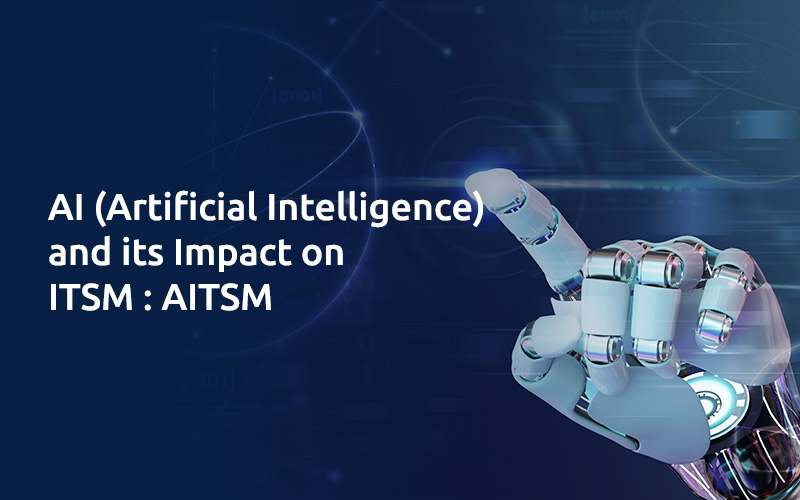
AI (Artificial Intelligence) and its Impact on ITSM: AITSM
There’s no denying that, in the next few years, the future of IT service management (ITSM) is closely intertwined with the possibilities of artificial intelligence (AI) and machine learning in particular. But what does this comment mean in terms of operations, and what must businesses do to guarantee that AI technology is used to improve their capabilities?
Challenges in introducing a new technology!
One of the issues with any technology is that we become infatuated with it and everything it can accomplish and we forget the fundamentals of any project that launches a new service: what is the intent? How will we know whether we’ve been successful? What impact will it have on our stakeholders (add value)? Understanding what is required to support and advance AI is also crucial to the long-term success of any effort. How will your organization’s use of AI technology match with its values, goals, and objectives? Just because AI can do something doesn’t imply it should be done.
People commonly believe that AI technology efforts will comprehend their surroundings and distinctiveness, but they forget that they are always developing and changing. A comprehensive understanding of how organizational and technical expertise will be gathered, organized, reused, and enhanced is required in addition to defined objectives. How will all of an organization’s implicit information become explicit, allowing machine learning technologies to reuse it to improve stakeholder experience? Where is the quality control that modifications are made in accordance with governance practices and controls?
The AITSM (Artificial Intelligence in ITSM) opportunity
There are three major AI prospects for ITSM firms right now. The first is Level or Tier 0.5, which involves offering a more engaging response, such as virtual agents or virtual support. It is self-service in the sense that the client doesn’t have to know how to write their query or use special vocabulary (at least, that’s the idea). A solid knowledge management technique may also use technology to support many languages, which is a big benefit for enterprises that need to support several languages. However, today’s difficulty is that individuals might focus on the variety of terminology used for what seems to be a simple topic by translating all of the assertions made.
The second use of AI is in supporting L1, L2and L3 service professionals with more difficult situations. Most individuals won’t recall everything, especially in a workplace where the rate of change is high or answering inquiries on a certain issue is uncommon.
The use of machine learning in analytics to uncover correlations that people can’t accomplish cost- effectively is the third field. There is a lot of data in service management systems, but very little of it is examined or used to make choices. AI technologies can not only correlate and discover causes, but they can also forecast/predict performance based on past data. Because humans are creatures of habit, previous data may be used to make accurate projections, allowing for better decision-making and risk management.
How AI Can Improve IT Service Management
- Due to the hundreds of outstanding laptop connectivity issues, remote support login, and VPN support queries still unanswered, a few CIOs with contact center-based Event Management systems can’t reach the bottom of incident queues.
- With all workers increasingly working from home, previous techniques to prioritize significant events aren’t keeping up with the volume, diversity, and velocity of inbound support requests.
- IT departments want their IT Service Management (ITSM) systems to automate the routing of significant issues to specialized teams in real time.
IT service operations teams and their management are now in the midst of their busiest weeks. As ITSM systems bog down under the weight of workloads they weren’t built for, they’re scurrying to enable many first-time work-from-home workers to become securely connected. Many firms have incident queues with hundreds of requests waiting to be assigned.
IT with AI and Predictive Analytics
A brief Pareto analysis of an Incident Management lineup with difficulty tickets reveals that the top 20% of connection and security login difficulties that all IT users confront account for 75 percent to 80% of service calls. Adopting an AI-based Incident Deflection method that finds the optimal IT service resource, starting with assistance materials and videos and continuing to an IT service agent, will quickly minimize the line.
The service bottlenecks produced by a first-in, first-out strategy are reduced by employing AI to match inbound IT requests with services agents across all channels. Algorithms must be taught to understand a particular IT request in light of each accessible IT agent’s distinct strengths and capabilities. Matching inbound requests that can’t be resolved by Incident Deflection with the best available agent can help IT companies minimize large issue tickets and Incident Management backlogs. The bottom line is that using AI to modernize ITSM has the potential to decrease IT expenses, minimize mistakes, and improve customer happiness while also boosting reaction times and speed. Best of all, IT agents will be able to focus on more difficult duties since AI will handle the more routine chores by continually learning how Incident Deflection, predictive routing, and performance analytics may be improved.
Roadmap to AI-Driven ITSM Starts with IT Operations Management
Nobody built an ITSM system expecting that everyone in a company would need help at the same time, and proof of this can be found in IT teams today. It’s time to reconsider IT’s platforms for supporting a totally virtual workforce.
ServiceNow Software’s premise is that AI is a core component of all technology systems and applications within an Autonomous Digital Enterprise, and their perspective on how IT needs to change to support more AI-enabled ITSM and other enterprise systems is one of the more interesting perspectives on how IT needs to change to support more AI-enabled ITSM and other enterprise systems. AIOps is frequently characterized as the use of AI and machine learning approaches to IT. As of the most recent quarter, Gartner reported a 25% rise in end-user enquiries on AIOps. It’s time to de-hype and demystify AIOps by using it to solve the most pressing business problems. Many IT service desks are now overburdened, which makes for a good first use case for putting the technology to work. To succeed, AI-enabled ITSM solutions will require an underlying IT infrastructure that can provide high-quality data for AI and machine learning algorithms to train on a continuous basis. The following are some key takeaways:
- For integrating ITOM and ITSM in their firms, 71% of IT leaders rely on SaaS-based technologies. Because of the speed, ease of deployment and upgrading, elastic scalability, and enterprise-grade performance, they prefer this method.
- Integration of ITOM and ITSM into a single platform is expected to enhance service quality, speed, and issue resolution for the majority of IT leaders. The majority of IT executives are driven by the possibility of more successfully managing data complexity, followed by speedier MTTR for service concerns.
- The ability to prioritize tickets based on impact, analyze their cause, and resolve them using convergent ITOM-ITSM is very critical or extremely important to 76 percent of IT leaders. IT incident reports may be prepared with information about the higher-level implications of problems with both the causal event (CI) and other impacted incidents using an integrated platform. IT can anticipate how critical business services or apps could be disrupted and focus resources and effort where they will be most useful.
